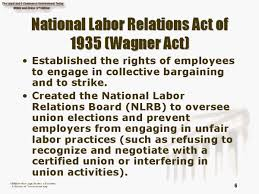Date in History : June 06, 1935
By far the most important labor legislation of the 1930s was the
National Labor Relations Act (NLRA) of 1935, more popularly known as
the Wagner Act, after its sponsor, Sen. Robert F. Wagner (NY-D). This
law included reenactment of the previously invalidated labor sections
of the NRA as well as a number of additions.
The NLRA was applicable to all firms and employees in activities
affecting interstate commerce with the exception of agricultural
laborers, government employees, and those persons subject to the
Railway Labor Act. It guaranteed covered workers the right to organize
and join labor movements, to choose representatives and bargain
collectively, and to strike.
The National Labor Relations Board (NLRB), originally consisting
of three members appointed by the President, was established by the
Act as an independent Federal agency. The NLRB was given power to
determine whether a union should be certified to represent particular
groups of employees, using such methods as it deemed suitable to reach
such a determination, including the holding of a representation
election among workers concerned.
Employers were forbidden by the Act from engaging in any of the
five categories of unfair labor practices. Violation of this
prohibition could result in the filing of a complaint with the NLRB by
a union or employees. After investigation, the NLRB could order the
cessation of such practices, reinstatement of a person fired for union
activities, the provision of back pay, restoration of seniority,
benefits, etc. An NLRB order issued in response to an unfair labor
practice complaint was made enforceable by the Federal courts.
Among those unfair labor practices forbidden by the Act were:
1) Dominating or otherwise interfering with formation of a labor
union, including the provision of any financial or other support.
2) Interfering with or restraining employees engaged in
the exercise of their rights to organize and bargain
collectively.
3) Imposing any special conditions of employment which tended either
to encourage or discourage union membership. The law stated,
however, that this provision should be construed to prohibit union
contracts requiring union membership as a condition of employment
in a company — a provision which, in effect, permitted the closed
and union shops. (In the former, only pre-existing members of the
union could be hired, in the latter. New employees were required
to join the union.)
4) Discharging or discriminating against an employee because he had
given testimony or filed charges under
the Act.
5) Refusing to bargain collectively with unions representing a
company’s employees.
The NLRA included no provisions defining or prohibiting as unfair
any labor practices by unions. The Act served to spur growth of U.S.
unionism — from 3,584,000 union members in 1935 to 10,201,000 by
1941, the eve of World War II. The 1941 figure represented more than
2? percent of the nonagricultural workforce in the U.S.

